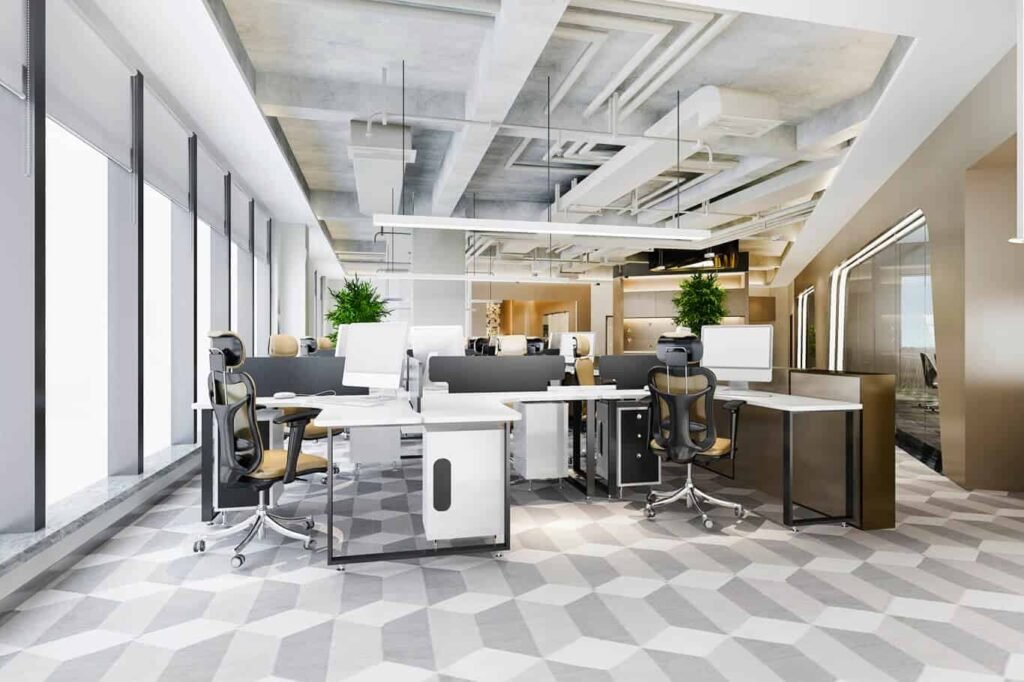Introduction
Office design plays a crucial role in creating a productive and inspiring work environment. While walls, furniture, and lighting often receive primary attention, ceiling design is an equally important yet often overlooked aspect. A well-designed office ceiling enhances aesthetics, improves acoustics, and contributes to energy efficiency. This article explores modern trends in office ceiling design that elevate workspace functionality and appeal.
The Role of Ceiling Design in Workspaces
The ceiling is more than just a structural component—it influences lighting, acoustics, and the overall ambiance of an office. A thoughtfully designed ceiling can:
- Improve acoustic comfort by reducing noise levels.
- Enhance lighting efficiency by reflecting and diffusing light.
- Contribute to energy efficiency with smart materials and insulation.
- Add aesthetic value, making the office feel modern and dynamic.
Modern Trends in Office Ceiling Design
1. Open Ceiling Concepts
Open ceilings, where structural elements such as pipes and ductwork are exposed, have become a popular trend. This industrial-inspired design gives offices a spacious, modern look while allowing easy access to maintenance systems. Combined with strategic lighting and suspended elements, open ceilings create an innovative and contemporary feel.
2. Acoustic Ceiling Panels
With open office layouts becoming the norm, noise control is a major concern. Acoustic ceiling panels made from sound-absorbing materials help reduce echo and improve speech clarity. These panels are available in various designs and colors, allowing for both functionality and aesthetics.
3. Suspended and Floating Ceilings
Suspended or floating ceiling panels add depth and dimension to office interiors. They create an artistic statement while concealing wiring, lighting fixtures, and HVAC components. These ceilings also allow for customization with dynamic shapes, textures, and lighting integration.
4. Smart and Interactive Ceilings
With the advancement of technology, smart ceilings featuring integrated LED lighting, motion sensors, and temperature control are transforming office spaces. These ceilings adapt to employee needs by adjusting brightness, ventilation, and even ambiance based on occupancy and time of day.
5. Biophilic Ceiling Designs
Bringing nature indoors through biophilic ceiling elements—such as green panels, wooden textures, and natural light reflectors—enhances employee well-being. These designs create a calming atmosphere, reduce stress, and improve air quality, making the workplace healthier and more inviting.
6. Geometric and Textured Designs
Adding 3D textures, perforated patterns, and geometric designs to ceilings adds a unique architectural touch to office spaces. These features create visual interest, define different work zones, and enhance creativity in modern workplaces.
Choosing the Right Ceiling for Your Office
When selecting a ceiling design, consider the following factors: ✅ Functionality – Ensure it meets lighting, acoustics, and energy efficiency needs. ✅ Aesthetic Appeal – Choose a style that complements your brand and office theme. ✅ Maintenance and Durability – Opt for materials that are easy to clean and long-lasting. ✅ Sustainability – Use eco-friendly materials that reduce environmental impact.
Conclusion
Office ceiling design is no longer just an afterthought—it is a critical element in shaping an efficient and visually appealing workspace. Whether opting for open ceilings, acoustic panels, biophilic elements, or smart technology, modern ceiling designs can enhance productivity and workplace experience. Investing in an innovative ceiling design not only transforms office aesthetics but also contributes to employee satisfaction and overall business success.

